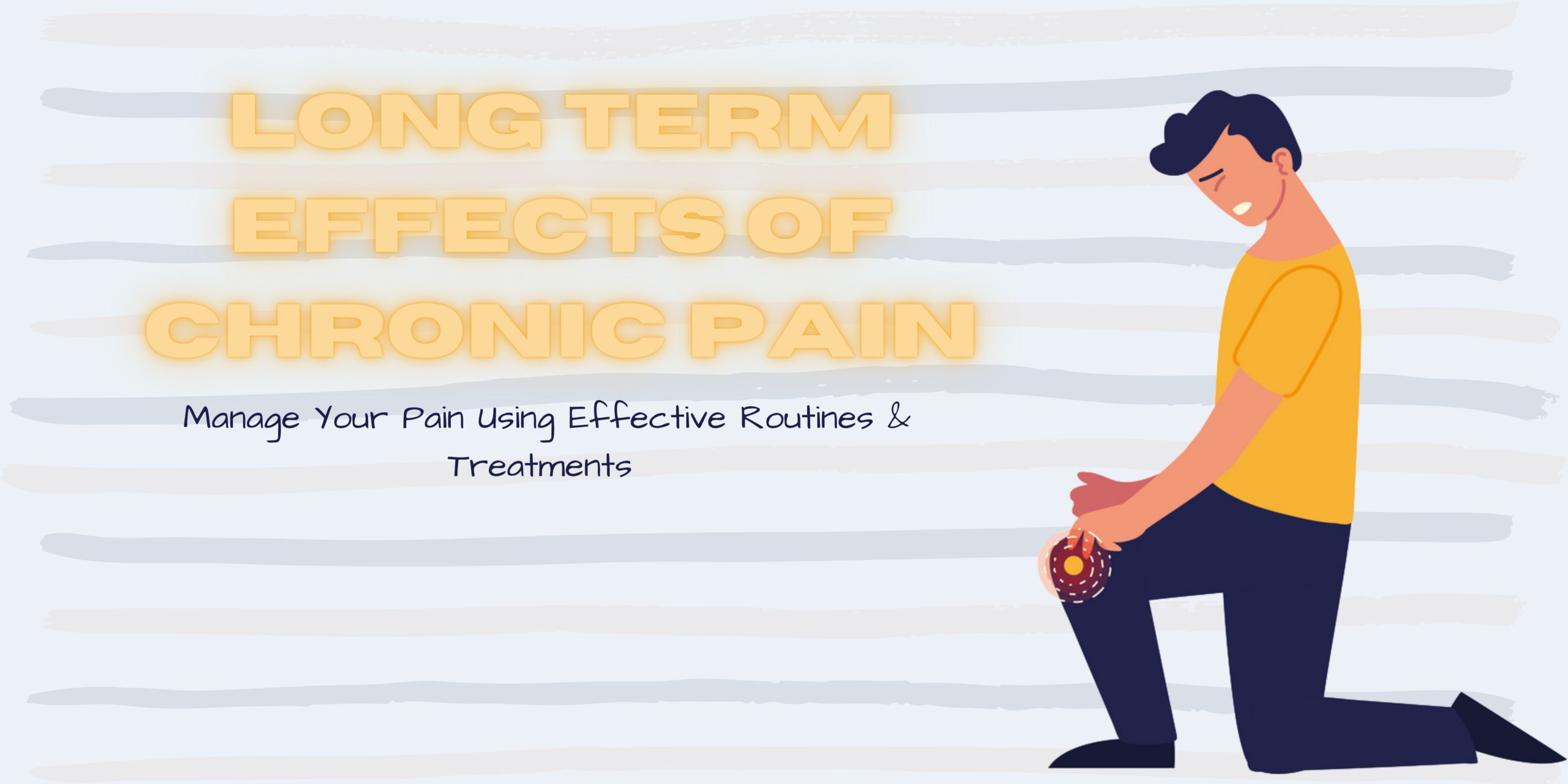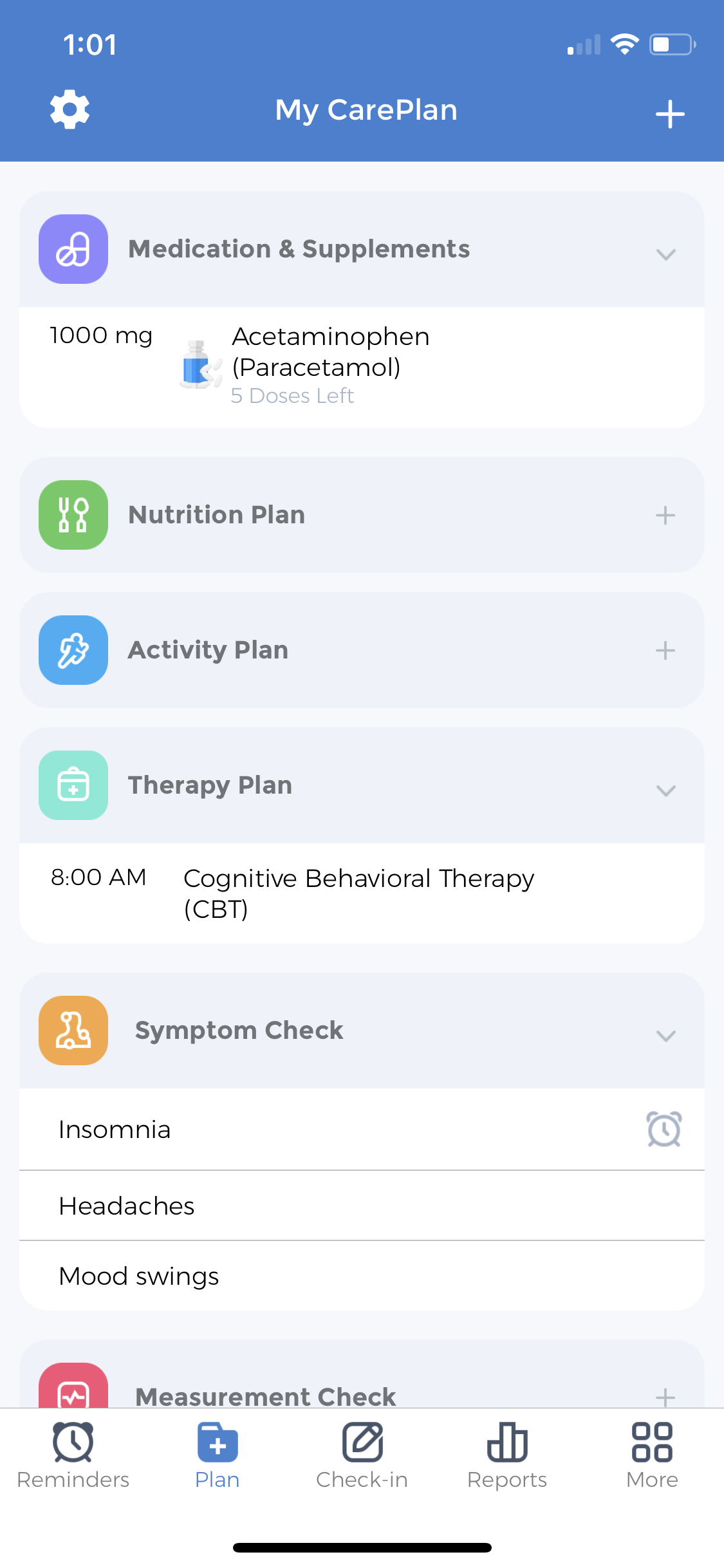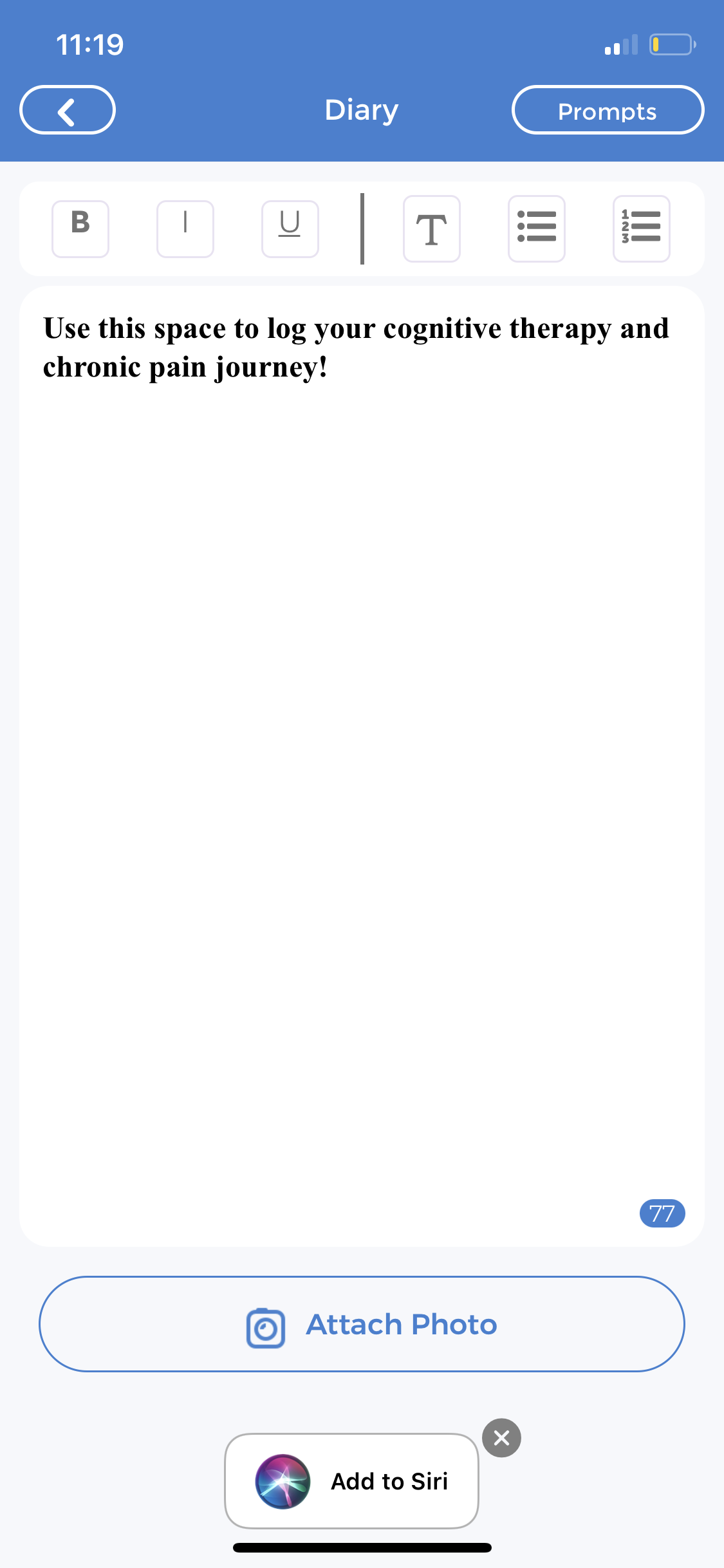
Have you suffered from persistent pain over a long period of time? Or perhaps a small injury and the pain never seemed to vanish? We all experience and respond to pain differently. It is a complex feeling and if occurred in long spans, it can have a detrimental effect on your health. Pain is often a signal by your body alerting you from harm. If the initial pain can’t be taken care of properly, it can aggravate and worsen the situation. This is referred to as chronic pain. Keep reading below to learn more about the effects of long-term pain and how the CareClinic app can help you manage it.
What is Chronic Pain?
Chronic pain is an ongoing, persistent pain that spans anywhere between three to six months or more. This type of pain sustains more than the suspected recovery period for a condition. These particular pain signals remain active in the nervous system for a long period of time. At times the pain can last more than a year. The pain can feel extremely sharp or can be dull. Chronic pain mostly causes a burning or aching sensation in the affected areas.
Understanding Short-Term Chronic Pain
Short-term chronic pain is referred to as acute pain. This type of pain spans under a shorter time span. The pain is caused by something specific. It can be a burn, a cut, a broken bone, and can also include childbirth. The experienced pain can be pointed towards a particular cause easily. In other words, it is easy to diagnose and physicians can attribute the pain to a specific treatment. Acute pain goes away once the affected area has been treated. It is mostly described as extremely sharp on the first impact before it eventually fades away over a short span.
Long-term chronic pain is often a result of untreated short-term acute pain. Chronic pain is caused by an underlying issue, some types of pain are untreatable through surgery and may not be able to heal. Pain patients may undergo a variety of treatments. This is why chronic pain is hard to diagnose and has the potential to be misdiagnosed.
What causes Acute Pain?
Acute pain is a sharp momentary pain. This can be caused by minor injuries and the pain is treatable. Once it’s gone, it’s gone. Some common causes of acute pain are the following.
- Surgery
- Post-operative pain
- Burns & cuts
- Dental surgery
- Broken bones
- Labor
- Childbirth
- Sprains
How to Treat Acute Pain?
There are several methods of treatment when it comes to acute pain. The treatment mostly depends on the affected area. This determines what remedy would work best. Once the pain has been identified, patients have plenty of treatment options to consider. Acute pain sounds simple but can be much more complicated. It is necessary to take into action the correct treatment at the right time.
Although there are many different avenues for treatment, some of the following is the most common treatment options.
- Application of heat or ice
- Raising the affected area if possible
- Resting the area and not putting further pressure on it
- Administering pain management medications such as a non-steroidal anti-inflammatory drug
Symptoms of Chronic Pain
Long-term Chronic pain varies from person to person. For some people, it is excruciating pain over a long period of time. For others, the pain is moderate or low in intensity. There are many alarms before, after and during periods of pain. These symptoms are helpful to physicians in addressing medical concerns. They can also help physicians identify causes of the long-term chronic pain. Some symptoms include, but are not limited to:
- Throbbing
- Burning
- Appetite changes
- Shooting
- Stinging
- Moodiness
- Soreness
- Stiffness
- Feeling very tired
- Not feeling hungry
- Self-isolation
- Lack of sleep
- Mood changes
- Weakness
- Loss of interest
- Lack of coordination
Causes of Chronic Pain
An estimated 20.4% of the entire U.S. population currently experiences chronic pain. This means more than 1 in 5 people report having persistent pain. Experiencing chronic pain can be very difficult and confusing. Many times doctors are unable to pinpoint a specific cause since there are many physical and environmental factors affecting persistent pain and stress.
Chronic pain is usually caused by an initial injury, such as a back sprain or pulled muscle. This is considered acute pain. Chronic pain develops after nerves become damaged. The nerve damage makes the pain more intense and persistent. In some cases, people experience chronic pain without any prior injury. The exact causes of chronic pain without injury aren’t well understood. This is why keeping a track of your symptoms can help your physician identify the root cause of chronic pain.
Chronic Pain Health Conditions
Rheumatoid Arthritis: This is an autoimmune disease that can cause joint pain and damage throughout your body. This causes inflammation in your joint linings leading to chronic pain. The disease commonly affects the hands, knees or ankles, and usually the same joint on both sides of the body. Rheumatoid arthritis can cause problems in other parts of the body as well, such as the eyes, heart and circulatory system.
Osteoarthritis: This is the most common type of arthritis and can affect any joint. It typically develops slowly over time. After a sudden injury, it can develop much more rapidly, within just a few years. Osteoarthritis is very common in older adults as they age. However, it is not an inevitable ageing disease because some people never develop it.
Fibromyalgia: This condition affects the muscles and the soft tissues. Fibromyalgia causes widespread pain and sensitivity to touch. The pain and tenderness tend to come and go and move about the body. This mostly affects the central nervous system.
Hyperalgesia: This condition is an enhanced pain response that can last a long time. It can result from either injury to part of the body or from the use of opioid painkillers. Hyperalgesia can lead to chronic pain if not treated correctly or could be misinterpreted as a chronic illness.
Psychological Effects of Chronic Pain
Chronic pain affects many aspects of your life, including mental health. Patients often neglect to address the psychological effects of their chronic pain. Ignoring the toll chronic pain has on the mind can overwhelming and cause other issues. Your mental state can exacerbate your physical pain, making it even more difficult to manage.
Depression
Some people who endure chronic pain also experience a major depressive disorder. Symptoms include constant sleep disturbances, appetite changes and feelings of self-isolation. Long-term pain can trigger a depressive episode. This goes for patients who have never before been diagnosed with depression before. Long-term pain also causes you to withdraw from physical activities or hobbies. Depression is very common among individuals suffering from chronic pain.
Guilt
Chronic pain prevents you from participating in activities that most people take for granted like socializing, working and exercising. Patients often feel angry blame themselves for no longer being able to engage with the world. While not a disorder by itself, feelings of guilt can overwhelm a person.
Insomnia
You need quality sleep to function. Chronic pain makes sleeping difficult. This can be due in part to the pain itself, as well as any medication side effects you may need to cope with the pain. Insomnia vastly impacts every aspect of your life. Lack of energy and motivation are some of the many aftermaths of insomnia. Insomnia can also accentuate psychological disorders like depression or anxiety.
When to See a Doctor for Chronic Pain
Whenever pain lasts longer than reasonably expected, it’s crucial to treat it to keep it from worsening into chronic pain. Acute pain can often turn into chronic pain if not healed in the correct manner. You might notice that the pain comes and goes. With chronic pain, the patients are more sensitive to pain due to the altered nervous system an additional strain on the human body. As a result, painful sensations might feel more severe and last longer.
It is important to see a doctor immediately if you feel your pain lasting longer than usual. An injury defined by acute pain might turn into everlasting chronic pain if untreated. Keeping a track of your pain intensity and tracking your pain will help you and your physician make informed decisions. Additionally, using cognitive behavioural therapy will help you manage your mood and keep help through your journey with chronic pain. The CareClinic application is a one-stop-shop for all your related healthcare needs.
Treatments for Chronic Pain
Treatment of long-term chronic pain includes managing underlying conditions with the pain as well. Chronic pain has a more significant impact than acute pain on a patient’s mental and emotional health. It is important to diagnose and provide treatment as early as possible to avoid an everlasting condition.
Medication
Medication is one of the most common pain management tools for persistent pain. Under the number of medications, there are oral medications such as non-steroidal anti-inflammatory drugs (NSAIDs), opioids, and over-the-counter medications like acetaminophen, paracetamol and ibuprofen. There are also topical analgesics that can effectively treat chronic pain like osteoarthritis, back pain and other neuropathic pains.
Cognitive Behavioural Therapy
Using Cognitive therapy for managing chronic pain is also a very common technique. A holistic view is essential in how we see chronic pain because those who suffer from it are usually at a higher risk of declined cognition, emotional reactivity and physical functioning. This multifaceted approach allows patients to view pain in another manner rather than seeing it under the umbrella of medications.
Cognitive behavioural therapy is an effective method of persistent pain therapy that can reduce pain psychologically. Cognitive Behavioural therapy involves talking with a therapist to help patients identify and develop skills to alter negative thoughts and behaviours. This type of therapy allows individuals to create their own experiences including pain. The approach to the feeling of pain is directed towards not just an outside situation or event. By changing negative thoughts and behaviours, patients undergoing this treatment become more aware of the pain. By becoming more aware you can develop better coping skills; even if the actual level of pain stays the same. The perception of persistent pain under the umbrella of medications depletes with cognitive therapy.
Managing Chronic Pain
The CareClinic app is a one-stop shop. Available to you 24/7. The user-friendly interface can help you easily keep track of pain in a log format through regular entries. The app is available on both iOS and Android. It is easy to use. Built for your ease.
Care Plans for Chronic Pain
Using Care Plans to manage your Chronic pain can help you stay on track and achieve your health goals within a reasonable time frame. Start by downloading the app and following the steps!
- Create a My Care Plan using the footer ribbon
- Add goals to achieve with your plan
- Add medication & supplements for pain relief (prescription or over-the-counter)
- Now you can invite friends or family members to be part of your care team

The care plan should include information about your medication dosage, the type of medication, frequency, and details on various therapies, activities and nutrition. Additionally, you can add in notes for all your personal information so that you can get a better overview of what works and what suits your condition.
The CareClinic allows you to also take care of your medication regime. If you are taking medication for pain management, you can set up reminders to ensure that you adhere to your medication regime. You can view the reminders in the calendar and use this feature for doctor appointments as well.
Adding symptoms into the pain management log is crucial. As soon as you have experienced a pain sensation, you can log the symptom into the CareClinic app. Keeping a track of other symptoms such as symptoms related to chronic pain is essential for accurate reports. This can help your physician identify patterns and information related to your condition. You can also mention when the symptom started and how long it took to stop. You can add notes directly, and connect your entries to existing health conditions. The application allows you to record multiple symptoms and even different types of pain.
Cognitive Therapy Support for Chronic Pain
There are a few ways that cognitive behavioural therapy helps you with pain relief. Firstly, it can change the way you view your pain. This type of behavioural therapy has the potential to change your thoughts and emotions. It alters the perspective of the feelings associated with the pain. It can teach you how to develop coping tactics. With this type of therapy, the distress is seen in a holistic manner and a different mindset. The purpose of the therapy is to help make your body’s natural pain relief system and response more controlling. Cognitive behavioural therapy can also change the physical response in your brain that makes your experienced pain more intense.
Personal Diary Tracking

Your personal health diary is how you keep track of any issues that may be of concern to you. It could be a place where you record your symptoms or where you record your health to-do list. Using this diary, you can easily access your reports and monitor any changes you observe throughout your journey.
Using the diary entry tab on the CareClinic App you are able, to sum up, all your thoughts in an unlimited number of entries per day. You are able to customize the entries to focus on your chronic pain therapy. You can jot down the progress of your treatment and notes from each session. Using diary entries ensures all your thoughts are in one place. You can also jot down the episodic pain levels and the emotional response associated with it for your health care provider. This feature can be used as a journaling prompt as well. If you’re unsure of what to write, use the prompt function. The premium account gives access to 16 journal prompts, and each prompt focuses on different aspects of mental health.
The layout also provides access to a space where you can also add lists, bold, italicize, and underline important statements. In-app users are also able to add photos to personalize your diary. The best part? CareClinic App users are able to add in as many entries to meet their needs. Diary entries automatically save to return to and work on the next day.
Monthly Diary Logs
At the end of each month, in the CareClinic application, you can find a detailed analysis of your pain and underlying conditions. Your physician can review this log and report to further support your healthcare journey and make adjustments. Your pain dairy will offer a consistent record of your pain. It is crucial to be as accurate as possible during your daily entries to obtain accurate correlations. Your doctor can use the information and come with a treatment plan that suits your current condition.
Informatics Support
The CareClinic app is customizable according to what you want to track and monitor. With its varying features, there is no doubt you will be able to find the best way to take control of your pain journey. It’s an all-around app that can help you to manage your pain and the ability to manage your goals, review your process and importantly obtain effective results. So what are you waiting for? Download the app and get started!


